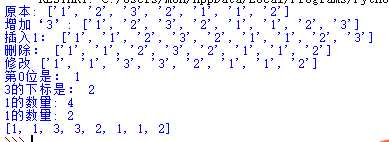标签:合数 muse append com 单词 有序 查询 词频统计 增加
1、实例: 下载一首英文的歌词或文章,将所有,.?!等替换为空格,将所有大写转换为小写,统计某几个单词出现的次数,分隔出一个一个的单词。/
abc=‘‘‘Models from different countries took to the catwalk in qipao, a traditional Chinese dress, at the first Shenyang Qipao International Cultural Festival held at the Shenyang Palace Museum in Shenyang, Northwest China‘s Liaoning province, on Tuesday.‘‘‘ abc=abc.lower() for i in ‘,.‘: abc=abc.replace(i,‘ ‘) qwe=abc.split() print(qwe) print(‘at ‘,qwe.count(‘at‘)) print(‘the ‘,qwe.count(‘the‘)) print(‘china ‘,qwe.count(‘china‘))

2、列表实例:由字符串创建一个作业评分列表,做增删改查询统计遍历操作。例如,查询第一个3分的下标,统计1分的同学有多少个,3分的同学有多少个等。
fen=list(‘1232112‘)
print(‘原本:‘,fen)
fen.append(‘3‘)
print(‘增加‘3’:‘,fen)
fen.insert(1,‘1‘)
print(‘插入1:‘,fen)
fen.pop()
print(‘删除:‘,fen)
fen[2]=‘3‘
print(‘修改‘,fen)
print(‘第0位是:‘,fen[0])
print(‘3的下标是:‘,fen.index(‘3‘))
print(‘1的数量:‘,fen.count(‘1‘))
print(‘1的数量:‘,fen.count(‘3‘))
for i in range(len(fen)):
fen[i]=int(fen[i])
print(fen)

3、简要描述列表与元组的异同。
1)list是一个使用方括号括起来的有序元素集合。list可以增删改查
2)Tuple是不可变的list.一是创建了一个tuple就不能以任何方式改变它。定义tuple与定义list的方式相同,除了整个元素集是用小括号包围的而不是方括号。
标签:合数 muse append com 单词 有序 查询 词频统计 增加
原文地址:http://www.cnblogs.com/888abc/p/7562113.html